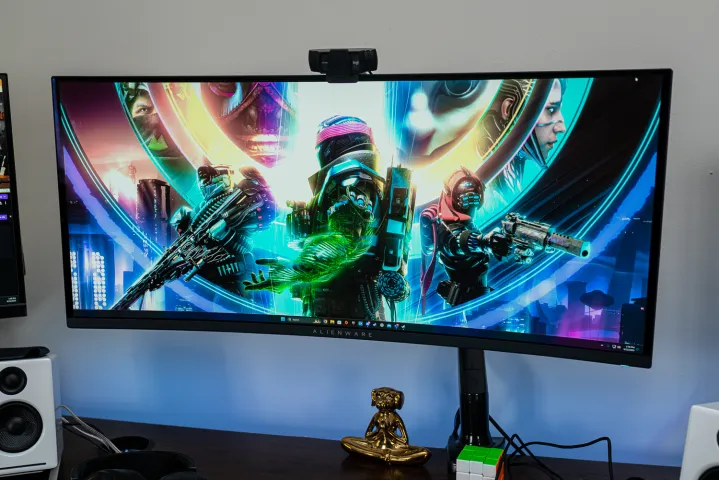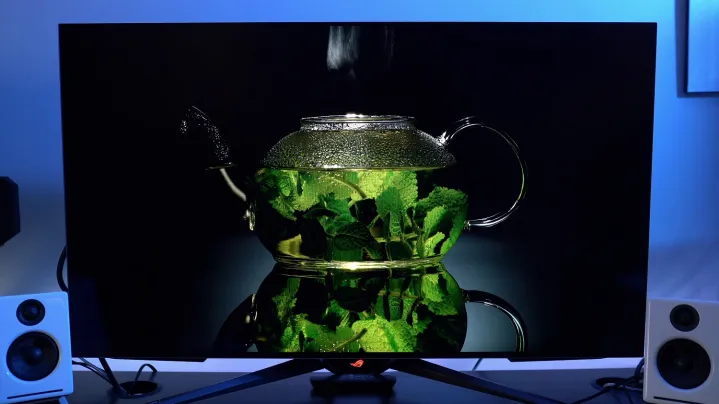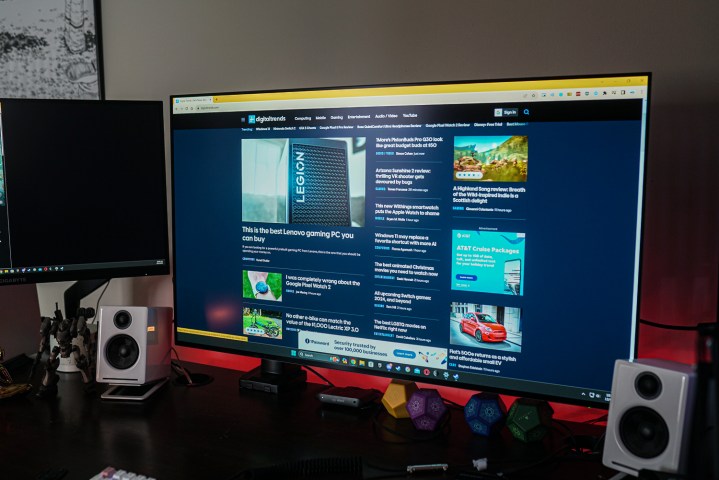
Call me crazy, but I traded in the best gaming monitor money can buy.
NEWSPAPER DOWNLOAD PROCESS – Watch NOW
” THE Hindu Newspapers Today Download —- DOWNLOAD “
Of course I’m talking about the Alienware 34 QD-OLED, which I bought about a year ago. I’ve loved it ever since, and immediately realized why it’s widely considered one of the most important gaming monitors released in recent years. However, a recent spate of holiday deals caught my eye, and I sold the monitor, which often tops review lists and charts, in exchange for something completely different.
I take KTC G42P5. I understand if you don’t know who KTC is — I didn’t either — but I rolled the dice on the screen after I found an Amazon deal that was too good to pass up. I’ve had the monitor for about a week now, and I’ve checked it out. And I was blown away.
Achieving the right price

Let’s start with why I chose this particular monitor. It’s a 42-inch OLED display, which, yes, I think sounds like a lot for a computer monitor. Yes, but I’m certainly not the first person to put a 42-inch screen in front of my PC. And in practice, a 42-inch 16:9 monitor is best it’s much closer in size to a 34-inch 21:9 monitor like the Alienware 34 QD-OLED than it sounds.
There are several reasons I wanted to switch back to 16:9. I want to be able to play console games on my home screen without black bars, and I want to be able to take 4K screenshots for the performance guides I write here on Digital Trends. More than anything, I just finished thinking about the problems that 21:9 brings.
The Alienware 34 QD-OLED is good, but I’m tired of playing with it Elden Ring with black lines or sucked out Alan Wake Up 2 every time a cutscene plays. At the same time, I don’t want to give up the perfect black levels of OLED or the large screen that the Alienware 34 QD-OLED offers me. The KTC G42P5 meets all my criteria, and at a price I can actually live with.

There are several other options if you are interested in this form factor. It uses an LG OLED panel, so it makes sense that you could use the 42-inch LG C3 OLED. There are some problems compared to KTC. For starters, it’s a TV, so it doesn’t have DisplayPort, and it’s more expensive. I spent $800 on a KTC screen, while the LG TV retails for $1,000, or $900 on sale. The LG has some advantages like image processing if you’re not worried about latency, but that wasn’t a problem for me.
Its main rival is the Asus ROG Swift PG42UQ. It’s a 42-inch monitor like the KTC, and overclocked to 138Hz (also like the KTC). It’s a nearly perfect monitor, but there’s one big problem. It costs $1,400. Even during holiday sales, I’ve never seen it on sale for less than $1,200 — that’s $400 more than I spent at KTC for essentially the same look.

Those are your only two options if you want this form factor. Older LG TVs like the C2 OLED are available, but for over $1,000, and the Gigabyte Aorus FV43U is cheaper, but not OLED. I bought the KTC G42P5 on sale for $800, but even now, the KTC G42P5 is available for $1,000 at the time of writing. That’s still $400 cheaper than the Asus display at list price.
The natural question is, why? If these are the same panels with the same features, why are they so much cheaper than the competition? Actually there are several reasons.
Why is it cheaper?

I assume you’ve never heard of KTC. This is a Chinese company that started rolling out displays in 2021, and the brand has just started hitting Amazon. KTC as a company is nothing new. KTC says it has been around for 27 years and serves as a display manufacturer for companies such as Samsung, ViewSonic, and LG. You may have never seen a KTC-branded monitor, but there’s a good chance you actually have own looking at the KTC monitor.
The idea here is that the middleman becomes the seller on KTC, which lowers the price slightly. That’s not a crazy idea in the world of technology. Even AMD, Intel’s biggest competitor in the world of processors, started its career as an Intel supplier before eventually developing into its own brand.
There’s a practical reason why this particular monitor is also cheaper than its competitors: It doesn’t come with a stand. It’s easy to forget how expensive a solid stand for a 42-inch display can be — $125, at least for KTC’s G42P5 stand — and KTC cuts that cost.

That could be a downside depending on what you want to do with the display. For me, that is a positive thing. I was able to save some money because I already had a monitor unit — about $50 on Amazon — and for a screen this big, there’s a good chance you’ll be mounting it on the wall. There are also TV mounts available for 100 x 100 VESA mounts for around $15. Regardless, there are some situations with a screen this big where you might not use the included stand, and at least you have the option to skip that with the KTC G42P5.
It’s worth noting that, even with the stand, the G42P5 comes in at $200 less than the ROG PG42UQ, so the savings don’t just depend on the stand.
The monitor itself

Now, we need to talk about the monitor itself. The KTC G42P5 uses an LG OLED RGBW panel, which is the same panel in the newer version of the LG C2. That means it looks great. OLED offers perfect black levels for unlimited contrast, as well as brightness low compared to LCD, still sufficient to cope with most ambient lighting conditions.
Digging into the numbers, I measured brightness of around 400 nits for 10% of the screen in SDR, and it jumped to above 600 nits for 3% of the window in HDR. Those numbers don’t sound high, but remember that this is a 42-inch screen. You don’t want it blasting 1,000 nits at you as a computer monitor.
In practice, I have two windows that directly emit light into my office, and I’ve never had any brightness issues, and that was when the panels were running at 30% of maximum. Unless you have very bright ambient lighting conditions, monitor brightness will not be an issue.
As for color, this OLED panel offers a wide gamut. This means it exceeds 100% of the sRGB gamut, pushing wider gamuts like DCI-P3. In that color space, I measured an incredible 97%.
Color accuracy is a different matter. KTC calibrates each monitor at the factory and includes a report, but the calibration is off, especially for DCI-P3 and Adobe RGB color modes. I measured a color error of 6 for Adobe RGB and 4 for DCI-P3, neither of which is great. In standard mode, the color error is above 3. Ideally, you want to see a color error below 2.
Nothing a little calibration can’t fix. Using the free DisplayCal, I calibrated the monitor, and it produced a color error of 0.6, which is very good.
It’s always nice when colors are perfect, but at least you can pull back the KTC if you need great color accuracy. However, this is not always important in practice. Of course, the colors weren’t up to par, but the display still looked great for games and movies before calibration.
Some weaknesses

There are several drawbacks here. For starters, the OSD (on-screen display) isn’t great. All the options are there, but it seems a bit choppy. For example, “overclock” is “overclock” in the menu, and some settings are not randomly capitalized. None of this really matters to the monitor’s performance, but it certainly makes you feel like you’re getting a cheaper product.
The bigger problem is Automatic Brightness Limiter (ABL). If you’re not familiar, all OLED displays have an ABL that limits brightness when you reach a certain threshold. In practice, this happens because the monitor quickly dims itself when you open something very bright like a white web page, and brightens when you open something darker, like a website in dark mode.
Ideally, ABL isn’t as visible on the screen as it is on my Alienware 34 QD-OLED, but it’s very aggressive on the G42P5. I constantly see the screen lighting up and limiting itself when I switch between browser tabs. This is especially annoying when I open the Windows search bar with a website open, because the screen immediately lights up with my dark mode Windows theme.
This is usually a deal breaker, but there are a few reasons why it’s not for me. First, this only applies with HDR. No problems in SDR, even though I set the screen to maximum brightness. ABL still works, but it’s less noticeable, and it’s fast enough that you won’t catch it often.
Second, this is never a problem in the games or movies. There are situations where ABL can occur and disrupt the media, but it is not common enough to be a problem. Based on my testing, it looks like ABL activates when about 60% of the screen is white, dimming to its lowest point when pure white reaches about 70% of the screen. That’s not enough to turn me off the G42P5, but my biggest complaint comes from the Alienware 34 QD-OLED.
The final issue is the OLED maintenance feature, but this is more of an annoyance than a problem. It starts automatically, giving you a 20 second countdown before the pixel refresh begins. I’ve had this happen several times, leaving me unable to use my PC for several minutes. Luckily, you can turn off automatic pixel refresh if you want.
Trading at its best

The KTC G42P5 is the perfect answer for me. While I love the Alienware 34 QD-OLED, I’ve also felt the 21:9 squeeze for a while, but I couldn’t justify spending $1,400 for the PG42UQ or more than $1,000 for LG’s 42-inch OLED. The KTC G42P5 delivers the right price with the right features, and with few sacrifices.
It’s not as smooth as the Alienware 34 QD-OLED, with disappointing color accuracy and annoying ABL in HDR. Luckily, these issues are easy to fix, making the KTC G42P5 a suitable replacement. It nails the screen real estate and excellent picture you get from OLED, and its price puts monitors like the PG42UQ to shame.
Editor’s Recommendations